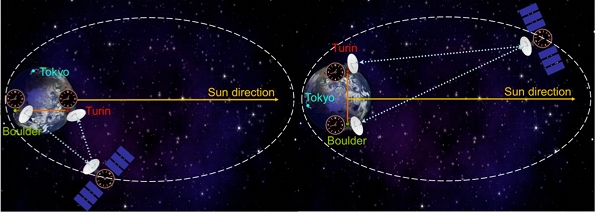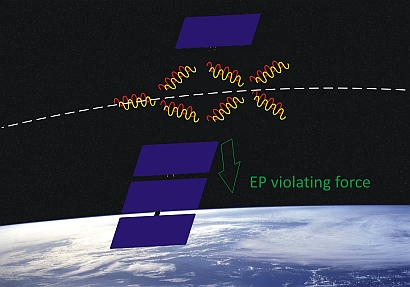Science goals
Einstein's Theory of General Relativity is a cornerstone of our current description of the physical world. It is used to describe the flow of time in the presence of gravity; the motion of bodies, from satellites to galaxy clusters; the propagation of electromagnetic waves in the presence of massive bodies; and the dynamics of the Universe as a whole.
Although successful so far, the Theory of General Relativity, as well as numerous other alternative or more general theories of gravitation, are classical theories. As such, they are fundamentally incomplete, because they do not include quantum effects. A theory that solves this problem by accounting for both relativistic and quantum effects would represent a crucial step towards the unification of all the fundamental forces of Nature.
Several approaches have been proposed and are currently under investigation: examples are string theory, quantum gravity, extra spatial dimensions. All of these tend to lead to tiny violations of basic principles. Therefore, a full understanding of gravity will require observations or experiments which can determine the relationship of gravity with the quantum world. This is currently a 'hot' topic and includes the study of dark energy.
Improvements in technology mean that several experiments can now be performed in space with significantly improved accuracy. Taking advantage of this, STE-QUEST is designed to test the different aspects of Einstein's Equivalence Principle using quantum sensors.
Einstein's Equivalence Principle (EPP) can be expressed as follows:
- Weak Equivalence Principle (WEP): The trajectories of freely falling test bodies are independent of their structure and composition;
- Local Lorentz Invariance (LLI): In local freely falling frames, the outcome of any non-gravitational test experiment is independent of the velocity of the frame;
- Local Position Invariance (LPI): In local freely falling frames, the outcome of any non-gravitational test experiment is independent of where and when in the Universe it is performed.
Primary Scientific Objectives of STE-QUEST
| Science Investigation | Measurement Requirement |
| Weak Equivalence Principle Tests | |
| Universality of propagation of matter-waves | Test the universality of the free propagation of matter waves to an uncertainty in the Eötvös parameter better than 2x10-15. |
| Gravitational Redshift Tests | |
| Sun gravitational redshift | Measurement of the Sun's gravitational redshift effect to a fractional frequency uncertainty of 2x10-6, with an ultimate goal of 5x10-7. |
| Moon gravitational redshift | Measurement of the Moon's gravitational redshift effect to a fractional frequency uncertainty of 4x10-4, with an ultimate goal of 9x10-5. |
|
Earth gravitational redshift (optional) |
Measurement of Earth's gravitational redshift effect to a fractional frequency uncertainty of 2x10-7. |
| Local Lorentz Invariance and CPT Tests | |
| LLI and CPT | Provide significant improvements on the determination of several parameters of the Lorentz and CPT symmetry violating Standard Model Extension. |
Weak Equivalence Principle Tests
Testing the Universality of Free Fall with Matter Waves
The Weak Equivalence Principle (WEP) postulates that the world line of a freely falling test body is independent of its structure and composition. This hypothesis is a cornerstone not only of Einstein's Theory of General Relativity, but also for almost all modern theories of gravitation.
Experimental tests of this principle are therefore based on the detection of tiny differential accelerations between test masses of different structure and composition.
The Eötvös parameter (η) is historically used to quantify a deviation from the WEP of two test bodies with different compositions (A and B), inertial mass mi, and gravitational mass mg:

An experiment measuring a value of η not equal to zero would disprove the universality of free fall and violate the Equivalence Principle.
In tracking the free propagation of matter waves, free-fall experiments extend into the domain of quantum objects. This approach is conceptually different from all other free-fall tests based on classical bodies. As per the principles of quantum mechanics, particles have to be described as wave packets; in the context of an atom interferometer (as adopted by STE-QUEST) this introduces the concept of coherence of the different partial matter waves.
STE-QUEST will compare the free-fall of the two isotopes of rubidium (85Rb and 87Rb) while the spacecraft orbits around perigee (see Figure below), in order to conduct a quantum test of the Weak Equivalence Principle with an accuracy down to 2×10-15.
|
|
|
Principle of the atom interferometry measurement to be performed with STE-QUEST. The spacecraft's atom interferometer compares the free fall of matter waves generated from ultra-cold rubidium isotope (85Rb and 87Rb) samples. Credit: ESA |
Gravitational Redshift Tests
A direct consequence of Einstein's Equivalence Principle is that time passes (or clocks tick) more slowly near a massive body. This effect can be detected when comparing the time intervals measured by identical clocks placed at different positions in a gravitational field, or when their tick rates (frequencies) are compared. Time and frequency can be transferred between remote locations using electromagnetic waves generated directly from the local clock and transmitted to a particular detection position (denoted by x').
The comparison of two clocks (i = 1, 2) with identical oscillation frequency and operating at different locations x1 and x2 yields a frequency ratio:
|
|
In this gravitational redshift formula, νi(x') is the frequency of clock i located at xi, as observed (measured) at the particular location x' where the comparison between the two clocks takes place (see Figure below); U is the gravitational potential. According to Einstein's Theory of General Relativity, this frequency ratio is universal, and independent of the nature of the clocks.
 |
|
Common-view comparison between Torino and Boulder for the test of Lorentz Position Invariance in the field of the Sun. Credit: ESA |
STE-QUEST will search for a possible violation of the gravitational redshift formula. Phenomenologically, such a violation may be described by a dependence on the gravitational potential of one or more of the fundamental constants that determine the clock frequency:
STE-QUEST will be able to compare distant ground clocks using the microwave link (MWL) in common-view mode. In the common-view technique, two ground clocks are simultaneously compared to the space clock. The difference of simultaneous measurements provides then a direct comparison of the two clocks on the ground. This measurement does not require a high-performance frequency reference on-board the STE-QUEST spacecraft. Indeed, the noise of the space clock, which appears as common mode in the two simultaneous link measurements, is rejected to high degree when the difference of the two space-to-ground comparisons is evaluated. According to the STE-QUEST reference orbit, common-view contacts between USA and Europe, Europe and Japan, Japan and USA have uninterrupted durations longer than 10 hours with each of them repeated every two days. After correcting for the second order Doppler effect, the diurnal modulations of the redshift effect due to the Sun or to the Moon field can be extracted due to their different time evolution.
Additional Science with STE-QUEST
| Science Investigation | Measurement Requirement |
| Clock Comparisons and International Atomic Time Scales | |
| Common-view comparisons of ground clocks | Common-view comparison of ground clocks at the 1x10-18 fractional frequency uncertainty level after a few days of integration time with the STE-QUEST microwave link and a few hours by using the optical link. |
| Space-to-ground time transfer | Space-to-ground time transfer with accuracy better than 50 ps. |
| Synchronization of ground clocks | Space-to-ground time transfer with accuracy better than 50 ps. |
| Atomic time scales | Contribution to the generation of atomic time scales to fractional frequency inaccuracy lower than 1x10-16. |
|
GNSS clocks and time scales (Optional) This scientific investigation can be performed only if the STE-QUEST payload is equipped with a high-stability and high-accuracy atomic clock. |
Monitoring of the stability of on-board GPS, GALILEO, and GLONASS clocks. |
| Geodesy | |
| On-site differential geopotential measurements | Differential geopotential measurements between two points on the Earth's surface with resolution in the gravitational potential U at the level of 0.15 m2/s2 (equivalent to 1.5 cm on the geoid height difference). |
| Reference Frames | |
| Earth terrestrial and celestial reference frame | Realization and unification of the terrestrial and the celestial reference frame of the Earth. |


